check engine HONDA CIVIC HATCHBACK 2019 (in English) Workshop Manual
[x] Cancel search | Manufacturer: HONDA, Model Year: 2019, Model line: CIVIC HATCHBACK, Model: HONDA CIVIC HATCHBACK 2019Pages: 699, PDF Size: 35.16 MB
Page 596 of 699

594
uuChecking and Maintaining Wiper Blades uChanging the Front Wiper Blade Rubber
Maintenance
7. Insert the flat side of the new wiper blade
onto the bottom part of the holder. Insert
the blade all the way.
8. Install the end of the wiper blade into the
cap.
9. Slide the holder onto the wiper arm until it
locks.
10. Lower both wiper arms.
11. Turn the ignition switch to ON
(w*1 and
hold the wiper switch in the MIST position
until both wiper arms return to the
standard position.
*1: Models with the smart entry system have an ENGINE START/STOP button instead of an
ignition switch.
Holder Wiper
Blade
Cap
19 CIVIC 5D HUM (KA KC KL)-31TGG6201.book 594 ページ 2018年10月25日 木曜日 午後4時12分
Page 604 of 699
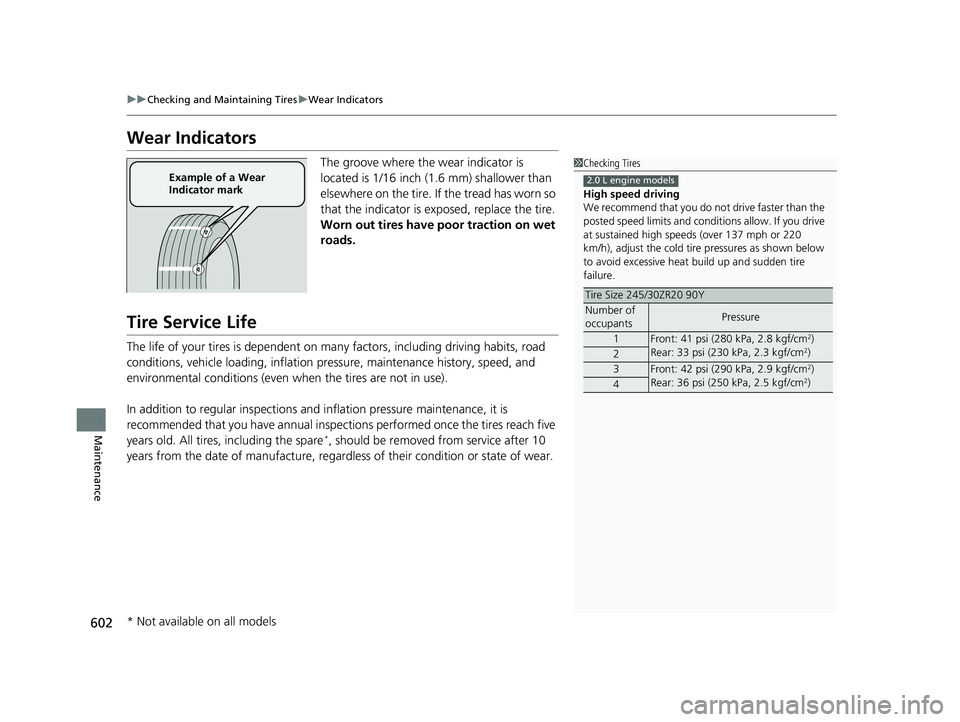
602
uuChecking and Maintaining Tires uWear Indicators
Maintenance
Wear Indicators
The groove where the wear indicator is
located is 1/16 inch (1.6 mm) shallower than
elsewhere on the tire. If the tread has worn so
that the indicator is ex posed, replace the tire.
Worn out tires have poor traction on wet
roads.
Tire Service Life
The life of your tires is dependent on many factors, including driving habits, road
conditions, vehicle loading, inflation pre ssure, maintenance history, speed, and
environmental conditions (even when the tires are not in use).
In addition to regular inspections and inflation pressure maintenance, it is
recommended that you have annual inspections performed once the tires reach five
years old. All tires, including the spare
*, should be removed from service after 10
years from the date of manufacture, regard less of their condition or state of wear.
1Checking Tires
High speed driving
We recommend that you do not drive faster than the
posted speed limits and condi tions allow. If you drive
at sustained high speeds (over 137 mph or 220
km/h), adjust the cold tire pressures as shown below
to avoid excessive heat build up and sudden tire
failure.
Tire Size 245/30ZR20 90Y
Number of
occupantsPressure
1Front: 41 psi (280 kPa, 2.8 kgf/cm2)
Rear: 33 psi (230 kPa, 2.3 kgf/cm2)2
3Front: 42 psi (290 kPa, 2.9 kgf/cm2)
Rear: 36 psi (250 kPa, 2.5 kgf/cm2)4
2.0 L engine modelsExample of a Wear
Indicator mark
* Not available on all models
19 CIVIC 5D HUM (KA KC KL)-31TGG6201.book 602 ページ 2018年10月25日 木曜日 午後4時12分
Page 609 of 699
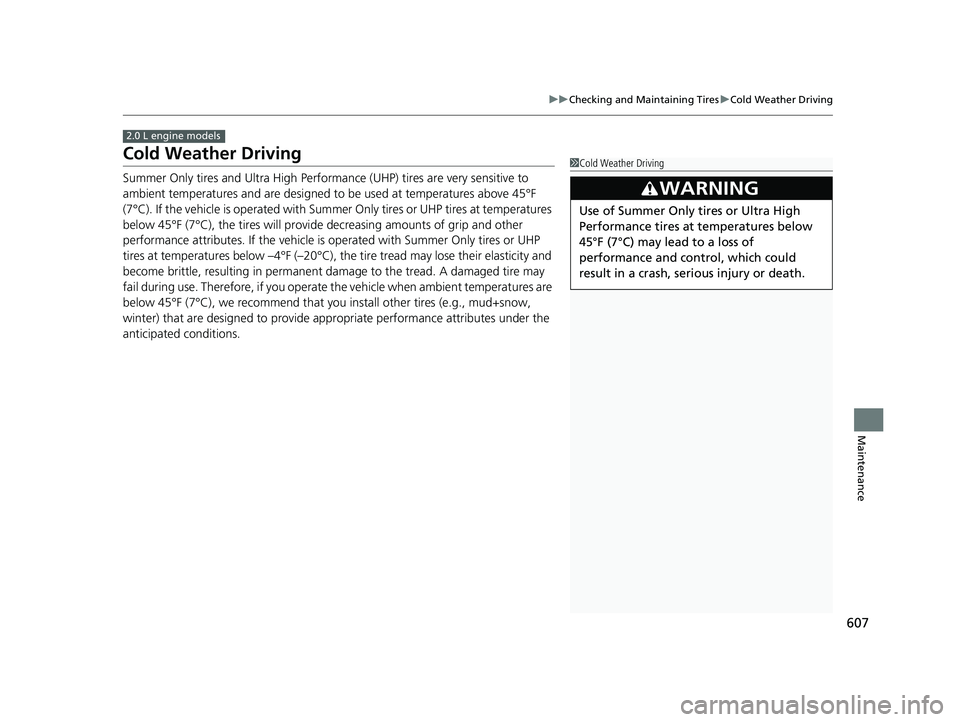
607
uuChecking and Maintaining Tires uCold Weather Driving
Maintenance
Cold Weather Driving
Summer Only tires and Ultra High Performa nce (UHP) tires are very sensitive to
ambient temperatures and are designed to be used at temperatures above 45°F
(7°C). If the vehicle is operated with Summe r Only tires or UHP tires at temperatures
below 45°F (7°C), the tires will provide decreasing amounts of grip and other
performance attributes. If the vehicle is operated with Summer Only tires or UHP
tires at temperatures below –4°F (–20°C), th e tire tread may lose their elasticity and
become brittle, resulting in permanent damage to the tread. A damaged tire may
fail during use. Therefore, if you operate the vehicle when ambient temperatures are
below 45°F (7°C), we recommend that yo u install other tires (e.g., mud+snow,
winter) that are designed to provide a ppropriate performance attributes under the
anticipated conditions.
2.0 L engine models
1 Cold Weather Driving
3WARNING
Use of Summer Only tires or Ultra High
Performance tires at temperatures below
45°F (7°C) may lead to a loss of
performance and control, which could
result in a crash, se rious injury or death.
19 CIVIC 5D HUM (KA KC KL)-31TGG6201.book 607 ページ 2018年10月25日 木曜日 午後4時12分
Page 623 of 699
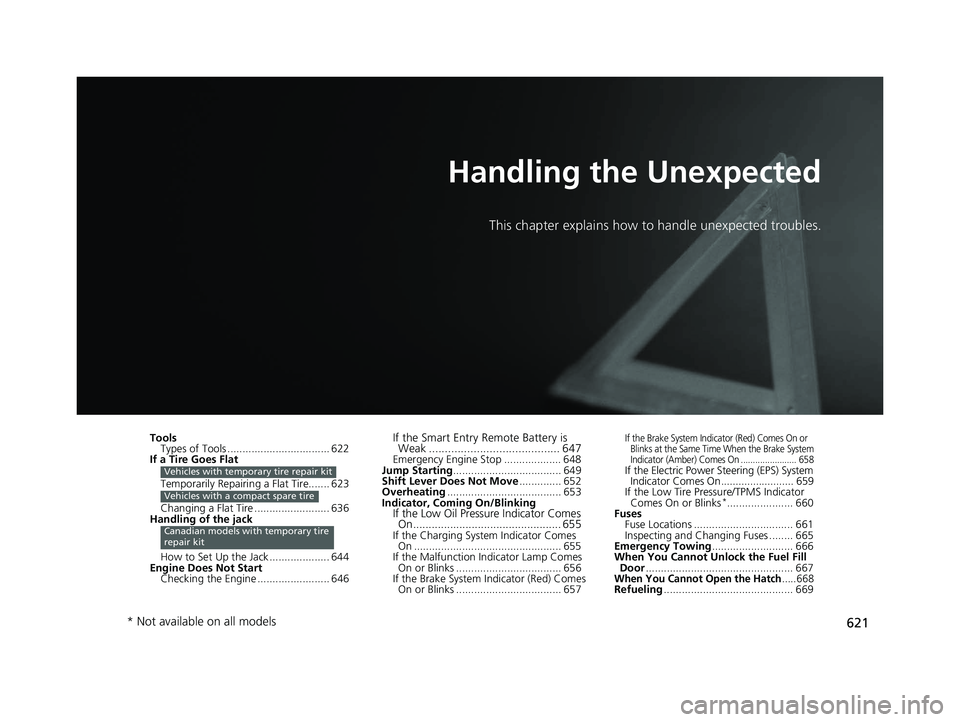
621
Handling the Unexpected
This chapter explains how to handle unexpected troubles.
ToolsTypes of Tools .................................. 622
If a Tire Goes Flat
Temporarily Repairi ng a Flat Tire....... 623
Changing a Flat Tire ......................... 636
Handling of the jack
How to Set Up the Jack .................... 644
Engine Does Not Start Checking the Engine ........................ 646
Vehicles with temporary tire repair kit
Vehicles with a compact spare tire
Canadian models with temporary tire
repair kit
If the Smart Entry Remote Battery is
Weak ......................................... 647
Emergency Engine Stop ................... 648
Jump Starting .................................... 649
Shift Lever Does Not Move .............. 652
Overheating ...................................... 653
Indicator, Coming On/Blinking
If the Low Oil Pressu re Indicator Comes
On................................................ 655
If the Charging System Indicator Comes
On ................................................. 655
If the Malfunction Indicator Lamp Comes
On or Blinks ................................... 656
If the Brake System Indicator (Red) Comes On or Blinks ................................... 657
If the Brake System Indicator (Red) Comes On or
Blinks at the Same Time When the Brake System
Indicator (Amber) Comes On ....................... 658
If the Electric Power Steering (EPS) System Indicator Comes On......................... 659
If the Low Tire Pressure/TPMS Indicator
Comes On or Blinks
*...................... 660
Fuses Fuse Locations ................................. 661
Inspecting and Changing Fuses ........ 665
Emergency Towing ........................... 666
When You Cannot Unlock the Fuel Fill
Door ................................................. 667
When You Cannot Open the Hatch.....668Refueling ........................................... 669
* Not available on all models
19 CIVIC 5D HUM (KA KC KL)-31TGG6201.book 621 ページ 2018年10月25日 木曜日 午後4時12分
Page 634 of 699
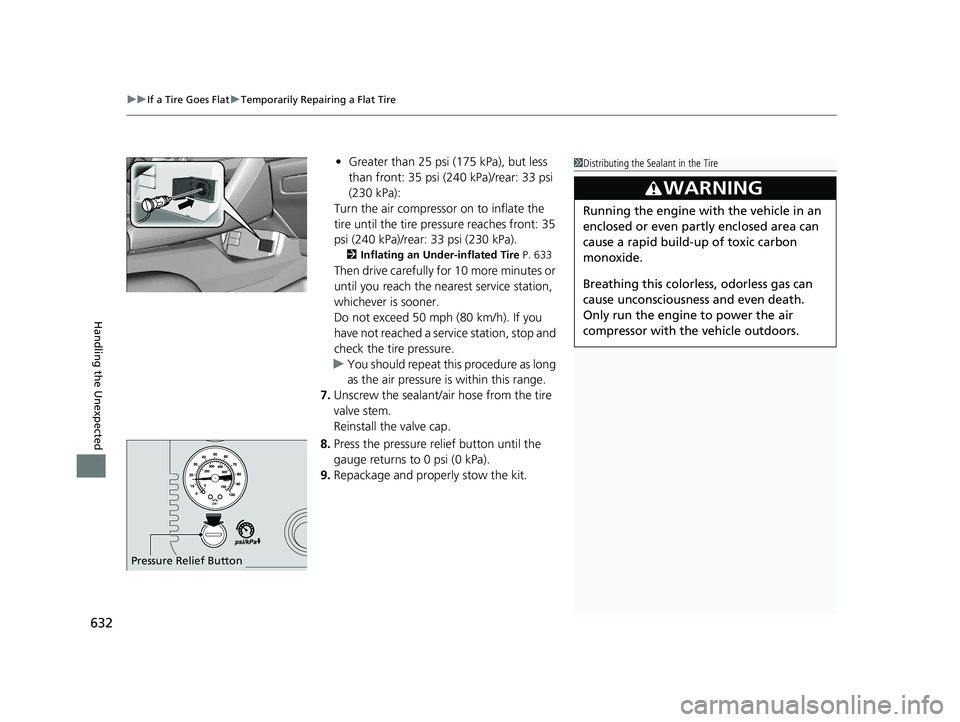
uuIf a Tire Goes Flat uTemporarily Repairing a Flat Tire
632
Handling the Unexpected
• Greater than 25 psi (175 kPa), but less
than front: 35 psi (240 kPa)/rear: 33 psi
(230 kPa):
Turn the air compressor on to inflate the
tire until the tire pressure reaches front: 35
psi (240 kPa)/rear: 33 psi (230 kPa).
2 Inflating an Under-inflated Tire P. 633
Then drive carefully for 10 more minutes or
until you reach the nearest service station,
whichever is sooner.
Do not exceed 50 mph (80 km/h). If you
have not reached a service station, stop and
check the tire pressure.
u You should repeat this procedure as long
as the air pressure is within this range.
7. Unscrew the sealant/ai r hose from the tire
valve stem.
Reinstall the valve cap.
8. Press the pressure relief button until the
gauge returns to 0 psi (0 kPa).
9. Repackage and properly stow the kit.
1Distributing the Sealant in the Tire
3WARNING
Running the engine with the vehicle in an
enclosed or even partly enclosed area can
cause a rapid build-up of toxic carbon
monoxide.
Breathing this colorless, odorless gas can
cause unconsciousness and even death.
Only run the engine to power the air
compressor with th e vehicle outdoors.
Pressure Relief Button
19 CIVIC 5D HUM (KA KC KL)-31TGG6201.book 632 ページ 2018年10月25日 木曜日 午後4時12分
Page 638 of 699
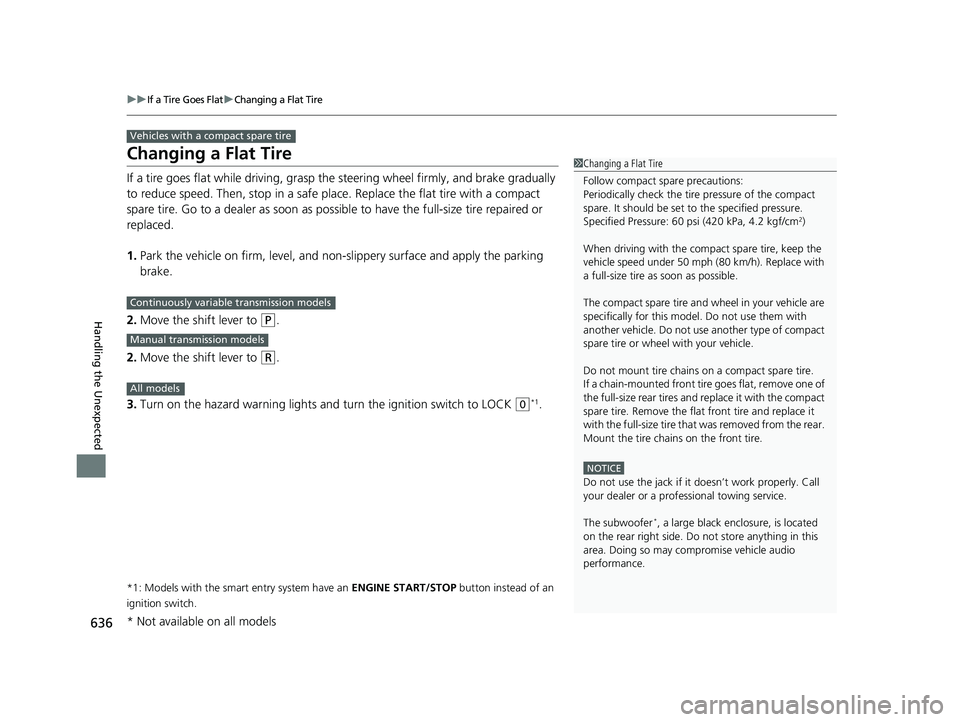
636
uuIf a Tire Goes FlatuChanging a Flat Tire
Handling the Unexpected
Changing a Flat Tire
If a tire goes flat while driving, grasp the steering wheel firmly, and brake gradually
to reduce speed. Then, stop in a safe place. Replace the flat tire with a compact
spare tire. Go to a dealer as soon as possibl e to have the full-size tire repaired or
replaced.
1. Park the vehicle on firm, level, and non- slippery surface and apply the parking
brake.
2. Move the shift lever to
(P.
2. Move the shift lever to
(R.
3. Turn on the hazard warning lights an d turn the ignition switch to LOCK
(0*1.
*1: Models with the smart entry system have an ENGINE START/STOP button instead of an
ignition switch.
Vehicles with a compact spare tire
1 Changing a Flat Tire
Follow compact spare precautions:
Periodically check the tire pressure of the compact
spare. It should be set to the specified pressure.
Specified Pressure: 60 psi (420 kPa, 4.2 kgf/cm
2)
When driving with the compact spare tire, keep the
vehicle speed under 50 mph (80 km/h). Replace with
a full-size tire as soon as possible.
The compact spare tire and wheel in your vehicle are
specifically for this model. Do not use them with
another vehicle. Do not us e another type of compact
spare tire or wheel with your vehicle.
Do not mount tire chains on a compact spare tire.
If a chain-mounted front tire goes flat, remove one of
the full-size rear tires and replace it with the compact
spare tire. Remove the flat front tire and replace it
with the full-size tire that was removed from the rear.
Mount the tire chains on the front tire.
NOTICE
Do not use the jack if it doesn’t work properly. Call
your dealer or a prof essional towing service.
The subwoofer
*, a large black enclosure, is located
on the rear right side. Do not store anything in this
area. Doing so may compromise vehicle audio
performance.
Continuously variable transmission models
Manual transmission models
All models
* Not available on all models
19 CIVIC 5D HUM (KA KC KL)-31TGG6201.book 636 ページ 2018年10月25日 木曜日 午後4時12分
Page 648 of 699
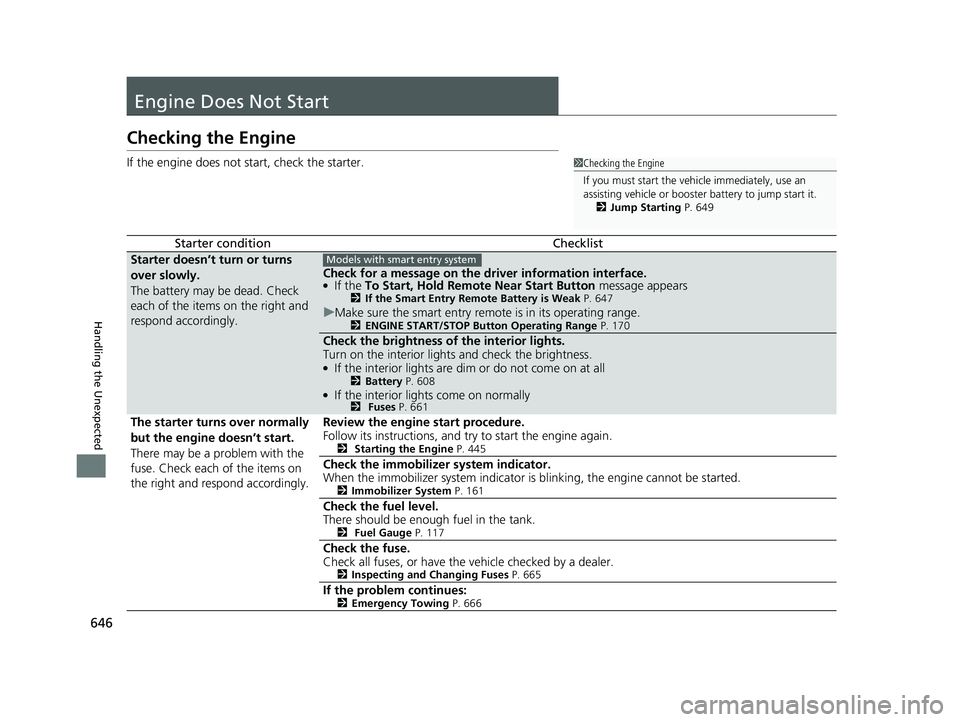
646
Handling the Unexpected
Engine Does Not Start
Checking the Engine
If the engine does not start, check the starter.
Starter conditionChecklist
Starter doesn’t turn or turns
over slowly.
The battery may be dead. Check
each of the items on the right and
respond accordingly.
Check for a message on the dr iver information interface.●If the To Start, Hold Remote Near Start Button message appears2If the Smart Entry Remote Battery is Weak P. 647
uMake sure the smart entry remote is in its operating range.2 ENGINE START/STOP Button Operating Range P. 170
Check the brightness of the interior lights.
Turn on the interior lights and check the brightness.
●If the interior lights are dim or do not come on at all2Battery P. 608●If the interior lights come on normally2 Fuses P. 661
The starter turns over normally
but the engine doesn’t start.
There may be a problem with the
fuse. Check each of the items on
the right and respond accordingly. Review the engine start procedure.
Follow its instructions, and try to start the engine again.
2
Starting the Engine P. 445
Check the immobilizer system indicator.
When the immobilizer system indicator is blinking, the engine cannot be started.
2Immobilizer System P. 161
Check the fuel level.
There should be enough fuel in the tank.
2 Fuel Gauge P. 117
Check the fuse.
Check all fuses, or have the vehicle checked by a dealer.
2Inspecting and Changing Fuses P. 665
If the problem continues:2Emergency Towing P. 666
1Checking the Engine
If you must start the vehi cle immediately, use an
assisting vehicle or booster battery to jump start it.
2 Jump Starting P. 649
Models with smart entry system
19 CIVIC 5D HUM (KA KC KL)-31TGG6201.book 646 ページ 2018年10月25日 木曜日 午後4時12分
Page 651 of 699
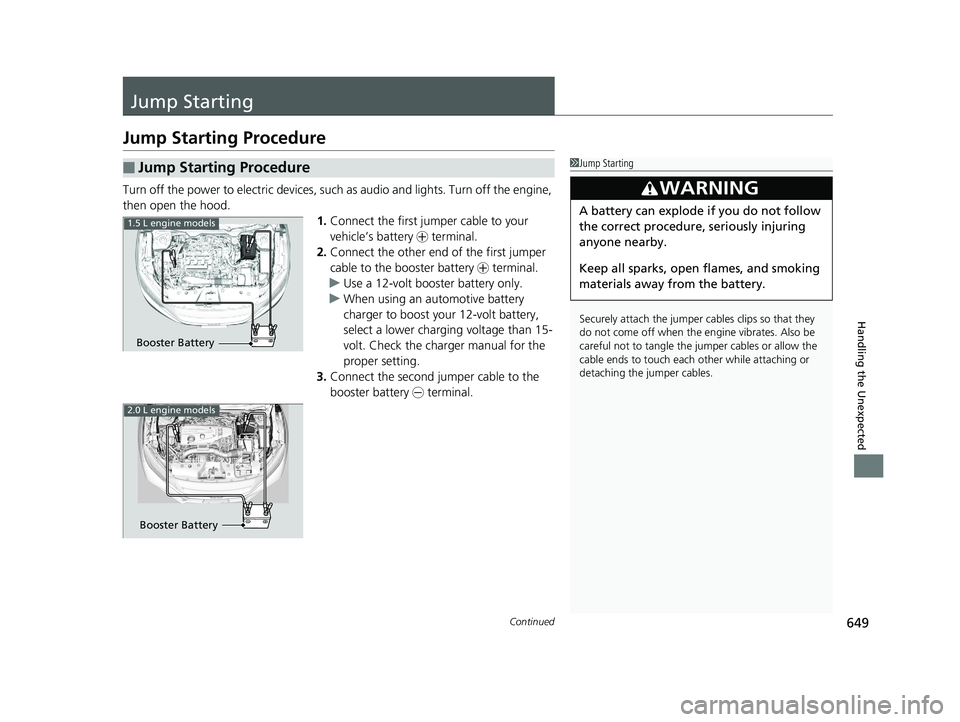
649Continued
Handling the Unexpected
Jump Starting
Jump Starting Procedure
Turn off the power to electric devices, such as audio and lights. Turn off the engine,
then open the hood. 1.Connect the first jumper cable to your
vehicle’s battery + terminal.
2. Connect the other end of the first jumper
cable to the booster battery + terminal.
u Use a 12-volt booster battery only.
u When using an automotive battery
charger to boost your 12-volt battery,
select a lower charging voltage than 15-
volt. Check the charger manual for the
proper setting.
3. Connect the second jumper cable to the
booster battery - terminal.
■Jump Starting Procedure1Jump Starting
Securely attach the jumper cables clips so that they
do not come off when the e ngine vibrates. Also be
careful not to tangle the ju mper cables or allow the
cable ends to touch each other while attaching or
detaching the jumper cables.
3WARNING
A battery can explode if you do not follow
the correct procedure, seriously injuring
anyone nearby.
Keep all sparks, open flames, and smoking
materials away from the battery.
Booster Battery
1.5 L engine models
2.0 L engine models
Booster Battery
19 CIVIC 5D HUM (KA KC KL)-31TGG6201.book 649 ページ 2018年10月25日 木曜日 午後4時12分
Page 652 of 699

uuJump Starting uJump Starting Procedure
650
Handling the Unexpected
4. Connect the other end of the second
jumper cable to the engine mounting bolt
as shown. Do not conn ect this jumper cable
to any other part.
5. If your vehicle is connected to another
vehicle, start the assisting vehicle’s engine
and increase its rpm slightly.
6. Attempt to start your vehicle’s engine. If it
turns over slowly, check that the jumper
cables have good metal-to-metal contact.1Jump Starting
Battery performance degrades in cold conditions and
may prevent the engi ne from starting.1.5 L engine models
2.0 L engine models
19 CIVIC 5D HUM (KA KC KL)-31TGG6201.book 650 ページ 2018年10月25日 木曜日 午後4時12分
Page 653 of 699

651
uuJump Starting uJump Starting Procedure
Handling the Unexpected
Once your vehicle's engine has started, re move the jumper cables in the following
order.
1. Disconnect the jumper cable from your vehicle's ground.
2. Disconnect the other end of the jumper cable from the booster battery -
terminal.
3. Disconnect the jumper cable from your vehicle's battery + terminal.
4. Disconnect the other end of the jumper cable from the booster battery +
terminal.
Have your vehicle inspected by a n earby service station or a dealer.
*1: Models with the smart entry system have an ENGINE START/STOP button instead of an
ignition switch.
■What to Do After the Engine Starts1 What to Do After the Engine Starts
The indicators for the Adaptive Cruise Control
(ACC)
*, Adaptive Cruise Control (ACC) with Low
Speed Follow (LSF)*, Road Departur e Mitigation
(RDM)*, Vehicle Stability Assist (VSA ®) System,
Vehicle Stability Assist (VSA ®) OFF, low tire Pressure/
TPMS
* and Collision Miti gation Braking SystemTM
(CMBSTM)* may come on when you turn the ignition
switch to ON ( w*1 after reconnect ing a battery.
Drive a short distance at more than 12 mph (20
km/h). The indicator should go off. If it does not, have
your vehicle checked by a dealer.
* Not available on all models
19 CIVIC 5D HUM (KA KC KL)-31TGG6201.book 651 ページ 2018年10月25日 木曜日 午後4時12分